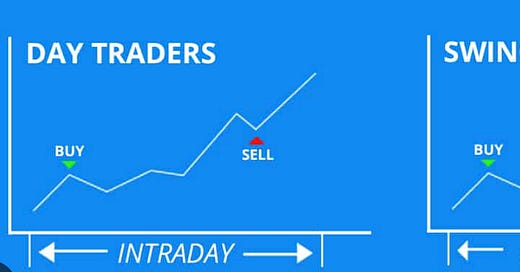Hello Traders,
In the complex world of trading, one of the first and most important decisions you’ll need to make is choosing the trading style that best suits your personality, lifestyle, and financial goals. Two of the most popular styles are day trading and swing trading. While both approaches can be highly profitable, they require different mindsets, strategies, and time commitments. Today, we’re going to dive into the key differences between day trading and swing trading, helping you determine which might be the better fit for you.
What is Day Trading?
Day trading involves buying and selling financial instruments—such as stocks, futures, or currencies—within the same trading day. The goal of a day trader is to capitalize on short-term price movements, often executing multiple trades throughout the day. Day traders close all positions before the market closes, avoiding overnight risk.
Key Characteristics of Day Trading:
Time Commitment: Day trading requires a significant time commitment. Traders must be glued to their screens, monitoring the markets and executing trades quickly. This style is best suited for those who can dedicate several hours a day to trading.
Frequency of Trades: Day traders often execute multiple trades per day, taking advantage of small price fluctuations. This high frequency of trading can lead to quick profits but also higher transaction costs.
Risk and Reward: The potential for quick profits is high, but so is the risk. Because positions are held for such short periods, the margin for error is small, and losses can accumulate quickly if trades go against you.
Technical Analysis: Day traders rely heavily on technical analysis, using charts, indicators, and patterns to make quick decisions. Fundamental analysis is less important since trades are based on short-term price movements.
Market Focus: Day traders often focus on highly liquid markets where price movements are frequent and volatility is high, such as the S&P 500, NASDAQ, or major currency pairs.
What is Swing Trading?
Swing trading, on the other hand, involves holding positions for several days to weeks, aiming to capture medium-term price movements. Swing traders look to profit from “swings” in the market—upward or downward price movements—over a more extended period compared to day traders.
Key Characteristics of Swing Trading:
Time Commitment: Swing trading requires less time commitment than day trading. Traders can spend a few hours each day analyzing the markets and managing their trades, making it a better option for those with full-time jobs or other commitments.
Frequency of Trades: Swing traders execute fewer trades compared to day traders. They may hold positions for days, weeks, or even months, depending on market conditions and the strategy used.
Risk and Reward: While swing trading carries less risk of rapid losses compared to day trading, it does involve overnight and weekend risks, such as market gaps or unexpected news events. However, the potential for significant profits is still substantial, especially if the trade captures a major trend.
Technical and Fundamental Analysis: Swing traders often use a combination of technical and fundamental analysis. They analyze charts and indicators to identify entry and exit points while also considering broader market trends and economic factors.
Market Focus: Swing traders can trade a wide range of markets, from stocks and ETFs to forex and commodities. They typically focus on trending markets, where price swings are more pronounced.
Day Trading vs. Swing Trading: Which is Right for You?
Choosing between day trading and swing trading ultimately comes down to your personal preferences, time availability, and risk tolerance. Here are some factors to consider:
Time Availability: If you have the time to monitor the markets throughout the day and enjoy the fast-paced nature of trading, day trading might be for you. If you have other commitments and prefer a more relaxed approach, swing trading is likely a better fit.
Risk Tolerance: Day trading can be more stressful due to the rapid pace and potential for quick losses. If you thrive under pressure and can handle the emotional ups and downs, day trading could be rewarding. Swing trading, with its longer time horizon, may appeal to those who prefer to take a more measured approach to risk.
Personality: Day traders need to be quick thinkers, able to make split-second decisions. Swing traders can afford to be more patient, waiting for the right opportunity to present itself. Understanding your own personality traits can help you choose the style that aligns with your strengths.
Capital Requirements: Day trading often requires more capital due to the need to meet margin requirements and to absorb the transaction costs of frequent trading. Swing trading, with fewer trades and longer holding periods, can be less capital-intensive.
Conclusion:
Both day trading and swing trading offer unique opportunities and challenges. By understanding the key differences between these trading styles, you can choose the one that best fits your lifestyle, goals, and personality. Whether you’re drawn to the adrenaline rush of day trading or the strategic patience of swing trading, both paths offer the potential for success with the right approach.
As always, I’m here to help you navigate the markets, and I encourage you to explore both styles to see which resonates with you. Remember, the most important thing is finding a trading style that you can consistently execute with discipline and confidence.
Wishing you all a successful trading week ahead. Let’s continue to conquer these markets together!
Cheers,
Ryan Bailey
VICI Trading Solutions




